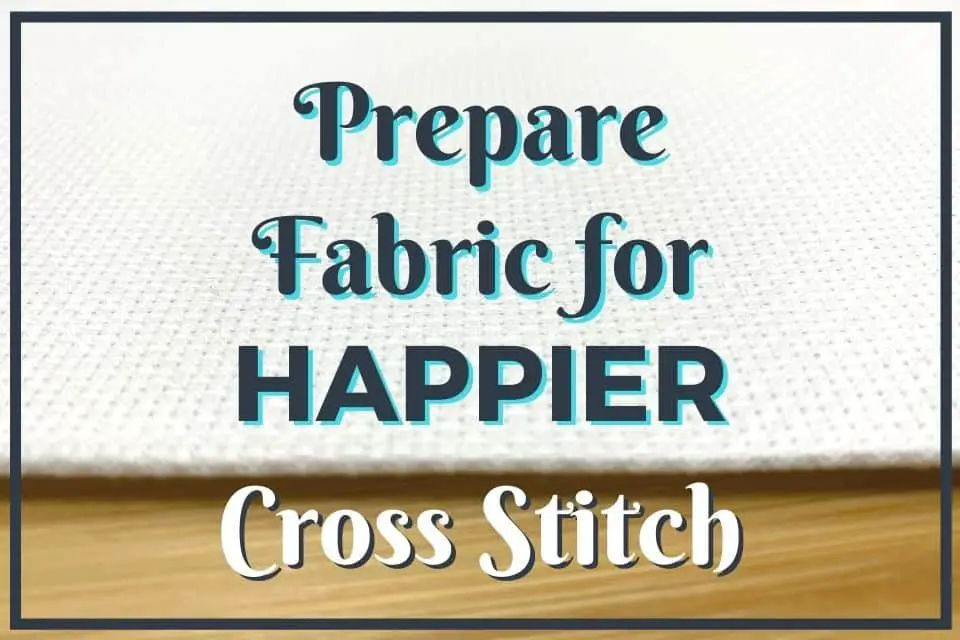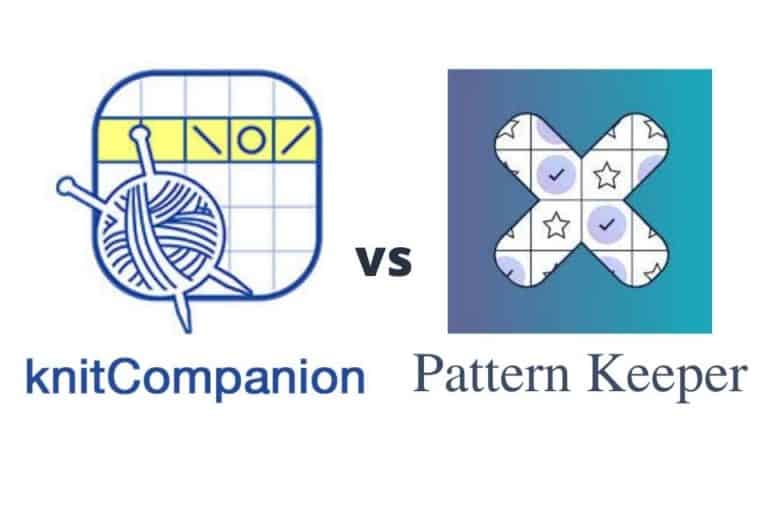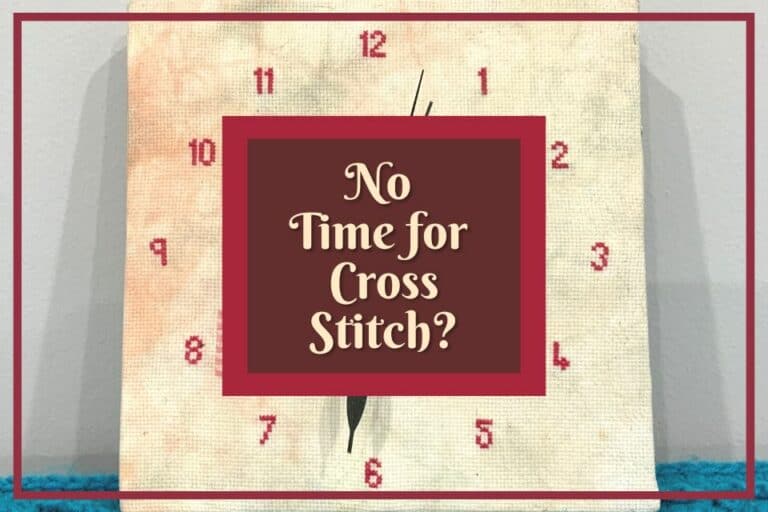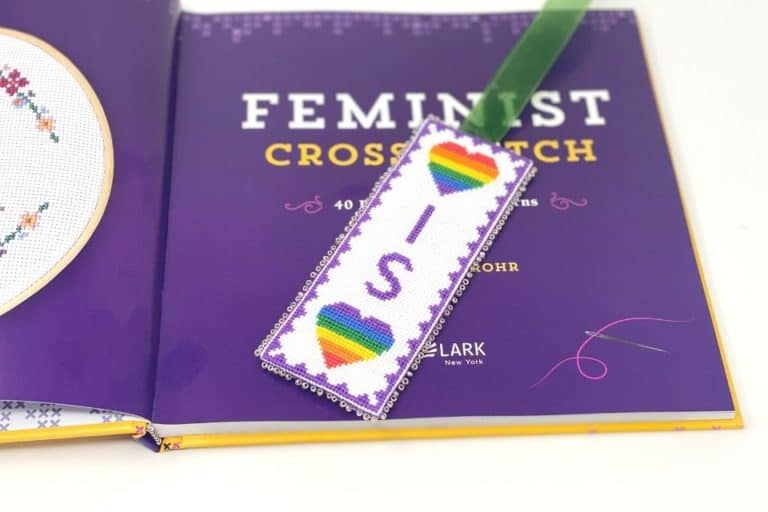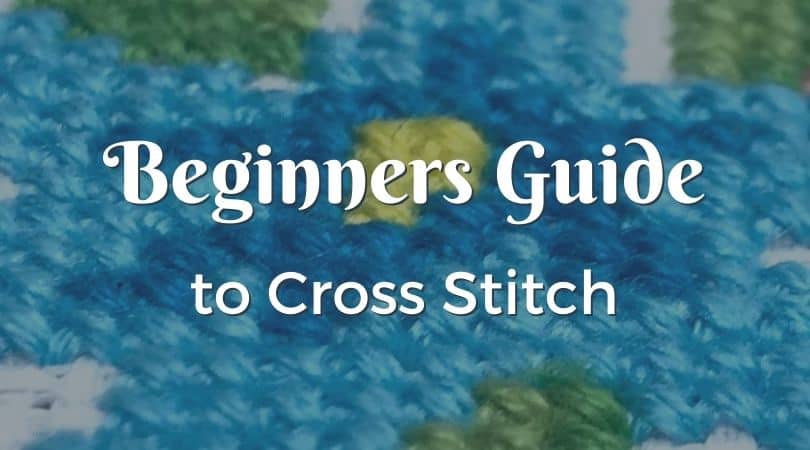Cross stitch should be a soothing, relaxing craft. Sometimes, though, we’re so excited about a new project that we want to jump right into it! But before you start stitching, a little prep work on your cross stitch fabric can save you a lot of frustration.
Will it hurt my cross stitch project if I don’t prepare my fabric first?
Your cross stitch project will still get done without doing any fabric preparation. But doing just a little extra work before that first stitch will create a much happier stitching experience.
Save yourself time and hassle with these few, quick steps.
And when you become a more experienced stitcher, you will settle into a routine that suits you. You may decide that some of these steps are unnecessary, and you may add more steps to your fabric prep routine.
When would you need to prepare your fabric for cross stitch?
Prepare your fabric for cross stitch after you’ve picked out a pattern and decided how you will frame it, but before you make the first stitch.
Watch the Prepare Fabric for Cross Stitch Tutorial Video
Quick Links to Helpful Info in This Article
- Will it Hurt My Cross Stitch if I Don’t Prepare My Fabric First?
- When Would You Need to Prepare Your Fabric for Cross Stitch?
- 1. Plan Your FFO (Fully Finished Object)
- 2. Wash Your Hands
- 3. How big should I cut my fabric?
- How Big Should I Cut My Cross Stitch Fabric for Framing in a Hoop?
- How Big Should I Cut My Cross Stitch Fabric for Framing in a Regular Picture Frame?
- How Big Should I Cut My Cross Stitch Fabric for Framing with a Mat Board and Frame?
- 4. Prevent Your Cross Stitch Fabric Edges from Fraying
- 5. Find the Center of Your Fabric
- 6. Should You Grid Your Fabric for Cross Stitch?
- 7. How to Place Fabric in an Embroidery Hoop
- 8. Do You Wash Your Fabric Before Cross Stitching?
- 9. Should you Iron Aida Before Cross Stitching?
1. Plan Your FFO (Fully Finished Object)
Knowing how you will turn your cross stitch into an FFO will help you prep your fabric and achieve happier stitching!
These are just a few examples of how planning for the finished cross stitch piece will help you figure out how to prep the fabric:
- Are you just stitching up something really quick, just for you?
- Less prep would be needed.
- Will it be framed and hung up on the wall?
- Better make sure you have enough extra fabric.
- Going to make it into a couch pillow?
- Wash the fabric ahead of time.
2. Wash Your Hands

First, before you handle the materials in your stash, you should wash your hands.
Do you have to? Nah.
But if you want to keep your textiles in tiptop shape while they sit for years in drawers and bins waiting for you to use them, just take 20 seconds and wash your damn hands. Besides, it’s good for your health, too!
3. Cut the Fabric to the Right Size
The next thing you need to do to prepare your fabric for cross stitch is to make sure you have the right sized piece of fabric at the start.
If your cross stitch fabric came as part of a kit, follow the directions in the kit. Usually, it’s precut to the exact size you need and you can skip this step.

Cutting your fabric too small is one of the hardest mistakes to fix, and the easiest to prevent! Save yourself the trouble of trying to salvage months of work and just give yourself a little extra room when cutting your fabric.
Click here to use the Cross Stitch Calculator to help.
When cutting your fabric before stitching, try to cut in straight lines. This makes it easy to measure. If the edge isn’t straight, the shortest edge will be what counts when framing and finishing.
This is where the planning I mentioned above comes into play.
How much extra fabric do you need for cross stitch in a hoop?
For cross stitch in a hoop, you need 2 or more extra inches of fabric on all four sides of your embroidery hoop.
Start with the stitching space. This will be listed on your pattern as the height and width of the space covered with stitches.

Click here for the Complete Guide to Embroidery Hoops.
Pick a hoop that is bigger than the stitching space. The amount of fabric between your stitching space and the edge of the hoop is called the border allowance in the cross stitch calculator.
Take the hoop size and add at least 2 inches to your fabric in all four directions.
That means cutting your fabric 4 inches longer than the diameter of the hoop, and 4 inches wider than the diameter of the hoop.
The 2 extra inches of fabric outside of the hoop is called the mounting allowance in the cross stitch calculator.

This will ensure that you have enough fabric to gather in the back of the hoop to finish as a hoop frame.

For crazy easy hoop framing ideas with video tutorials, click here.
How much extra cross stitch fabric do you need for cross stitch in a frame?
For cross stitch in a frame, you need 3 or more extra inches of fabric on all four sides of a frame.
Start with the stitching space. This will be listed on your pattern as the height and width of the space covered with stitches.
Then, pick out a frame and check that the stitching space will fit inside the frame. The space between your stitches and your frame is called the border allowance in the cross stitch calculator.
Finally, cut your fabric to be 3 inches larger than the frame on all four sides.
This means that the height of your fabric should be 6 inches more than the height of your frame. And that the width of your fabric should be 6 inches more than the width of your frame.
The 3 extra fabric inches larger than the frame is called the mounting allowance in the cross stitch calculator.
Video Tutorial for Framing with Sticky-Back Mounting Board
If you use a sticky-back mounting board, you can get away with a little less fabric allowance for mounting.
How big should I cut my cross stitch fabric for framing with a mat board and frame?
Start with the stitching space. This will be listed on your pattern as the height and width of the space covered with stitches.
Then, pick out a mat board and check that the stitching space will fit inside the mat board.

Choose a mat board to fit your frame.
Choose a frame that will fit the mat board. The inner dimensions of the frame should match the outer dimensions of the mat board.
Finally, cut your fabric to be 3 inches larger than the frame on all four sides.
This means that the height of your fabric should be 6 inches more than the height of your frame. And that the width of your fabric should be 6 inches more than the width of your frame.
“That’s WAY too much fabric!”
— My Mom (who STILL cuts her fabric too small #IJS)
It can’t hurt to have too much fabric. You can always cut it off later, but you can’t add more back on!
If you’re unsure of the math, I’ve created this Cross Stitch Calculator to help you. Remember, double check the numbers before cutting!
4. Prevent Your Cross Stitch Fabric Edges From Fraying
The next step to preparing your fabric for cross stitch is to secure the edges from fraying. The prevents loose strings from the edges of your fabric from sneaking their way into your stitches.
Sewing the Edges
The traditional way to prevent your fabric from fraying is to sew the edges. You can sew on a sewing machine using a zig-zag stitch. Or sew the edges by hand using a zig-zag stitch or blanket stitch.

Learn the blanket stitch in this hoop finishing tutorial.
Other (Faster) Ways to Prevent Fraying
The fastest way would be to use pinking shears. Pinking shears are a special kind of fabric scissor that will cut your fabric in a zig-zag pattern.

Another way to secure the edges of your fabric is to use a low-adhesive tape, like masking tape or painters tape. Both kinds of tape are quick and effective. Using tape is the method I use most often to secure the edges of my cross stitch fabric because I always have tape lying around. If you’re concerned about sticky residue getting left behind on your fabric, use painter’s tape.

The last no-sew method for securing your fabric that I recommend is to use a fabric sealant such as Fray Check. This might take a little more time since you have to wait for it to dry.
Test the fabric sealant on a separate sample of fabric first. Check the label for drying times and always follow safety instructions.

See how to use these no-sew methods for preventing cross stitch fabric from fraying here.
5. Find the Center of Your Fabric
After cutting your cross stitch fabric to size and securing the edges to prevent fraying, you need to find the center. This is necessary, but really easy.
Fold the fabric in half.

Turn the folded fabric 90 degrees – or one-quarter of a circle.

Fold the fabric in half again.

Then, mark the center stitch with a pin, needle or a half stitch.

Now when you unfold the fabric, you have the center marked and ready.

Finding the center of your piece of fabric before stitching allows you to easily start stitching from the middle. Most patterns will indicate where the center stitches are to help you do this. Starting in the middle of the fabric ensures that your finished stitches are centered on the fabric so that you have plenty of room on all sides for finishing and framing.
6. Should You Grid Your Fabric for Cross Stitch?
Beginners should start with a small project, which doesn’t need gridding. But gridding your fabric in preparation for cross stitch can be especially helpful with larger projects.

Gridding makes your fabric look more like your pattern chart by dividing the fabric into 10×10 sections – just like in your chart. And it helps prevent mistakes, which saves you time and frustration from “frogging” (rip-it, rip-it!) your stitches.
Ready to stitch a big project and give gridding a try?
7. Place Fabric in an Embroidery Hoop
The last thing you can do to prepare your fabric for cross stitch is to place it in a hoop or frame.
This step is optional because you can stitch “in hand”. (I do!) If you’re just starting out, you should use an embroidery hoop. This helps you hold the fabric more easily, and keeps the tension of the fabric firm. Firm fabric is much easier to stitch on, and helps your stitches stay neat and even.
Choose an embroidery hoop that is smaller than the piece of fabric you will be stitching. If you are stitching on a very large piece, you can use an embroidery hoop that is smaller than your stitching area and move it around your fabric as you stitch.
Learn more in the Complete Guide to Embroidery Hoops for Cross Stitch
First, loosen tension by unscrewing the tension screw

Separate the inner and outer pieces of the embroidery hoop.

Place the inner piece of the hoop on a flat surface. Center your cross stitch fabric over the inner hoop.

Place the outer piece of the hoop over your fabric so that it is on top of the inner piece of the hoop. Push the outer piece of the hoop down until it slides over and around the inner piece of the hoop that is under the fabric.

Tighten the embroidery hoop.

Gently tug at the edges of the fabric stitching out of the edges of the hoop. Don’t pull too hard or you’ll distort the fabric. Just pull enough so that the fabric is taut and not at all floppy.
8. Do you wash fabric before cross stitching?
Check the manufacturer’s care instructions before washing your fabric.
There are only two reasons (that I know of) to wash your fabric before cross stitching: to preshrink cotton fabric or to remove starch or dye.
Aida, evenweave and linen are the most common fabrics to cross stitch on, and they all come in cotton (among other materials). Cotton shrinks when washed! If your project will be sewn into something else when done, such as a pillow or a patch on a jacket, you should wash it before stitching. This will effectively pre-shrink the cotton, so it won’t pucker after you attach it to the finished item.

The other reason to wash your cross stitch fabric would be to remove the starch or some of the dye. Most aida and some other stitchy fabrics are starched to make them more stiff. Most of the time, stiff fabric is easier to stitch on. But if you enjoy stitching on softer fabric, or if you prefer to stitch on starchless fabric, you should wash it as part of the preparation process for cross stitching.
If you’ve purchased dyed fabric – or dyed it yourself – and the color is too dark, you can wash it to remove some of the dye and de-saturate the color. This could dramatically change the color, so try it on a small piece of fabric first to see if you like the effect.
9. Should you iron aida before cross stitching?
There’s no need to iron aida or other fabrics before cross stitching. They will just get wrinkled from holding them while you stitch, or from placing them in a hoop.
Theoretically, ironing the fabric might help when cutting it, but I have been stitching for decades and folded or wrinkled fabric has never been a problem for cutting or stitching.

Preparing your fabric for cross stitch will not only help you stitch faster and easier, giving you a happier stitching experience. It will save you time and frustration when you’re ready to turn it into a FFO (Fully Finished Object) if you take these few, simple steps before making that first stitch.

